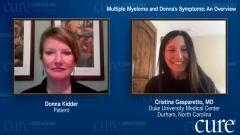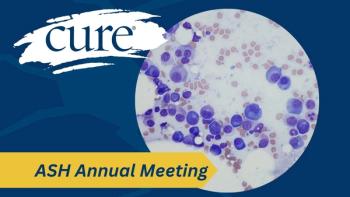
Multiple Myeloma First- and Second-Line Therapies for Donna
Donna and Dr Gasparetto converse about the many first- and second-line therapies for multiple myeloma.
Episodes in this series

Cristina Gasparetto, MD: You were on Kyprolis. Did you get Kyprolis twice a week, or once a week?
Donna Kidder: I got it twice a week the very first time, I believe. But then once a week after that.
Cristina Gasparetto, MD: Once a week. Kyprolis can be given twice a week, or once a week now is approved in different combinations. But still, you have to go to the doctor’s office on day one and two. On day one, every week for three weeks, with one week break. Some patients must travel a distance, so sometimes you choose oral combination or combinations that involve fewer visits. Or some patients need to be followed very closely. So, there are so many treatment options right now, particularly after Darzalex was approved. We have combinations with Darzalex, the new IMiDs [immunomodulatory drugs], pomalidomide, bortezomib. Carfilzomib was recently approved. We also had another antibody, isatuximab, recently approved with pomalidomide and carfilzomib. These are the most commonly used. And then new approaches by mouth, selinexor. We’ll talk about selinexor in a bit. Back then you were not yet with me. I think your second line was chosen by your primary oncologist, still in collaboration with the Little Rock team.
Donna Kidder: That’s correct.
Cristina Gasparetto, MD: They chose carfilzomib in combination with what?
Donna Kidder: I’m pretty sure it was dexamethasone and Pomalyst.
Cristina Gasparetto, MD: Pomalidomide. Yes.
Donna Kidder: Yes.
Cristina Gasparetto, MD: I remember now. You were on carfilzomib, pomalidomide and dexamethasone. You had a pretty good response, right?
Donna Kidder: It was immediate. It dropped so fast; it was unbelievable.
Cristina Gasparetto, MD: Yes. Again, they switched your therapy. At the beginning you were treated with lenalidomide and bortezomib, right?
Donna Kidder: Yes.
Cristina Gasparetto, MD: Initially, I said chemotherapy, but actually in 2012, that was your therapy, the standard of therapy that we still offer. Then you had the stem cell collection, and the transplant. So, they went to a different IMiD, lenalidomide to pomalidomide, and then from bortezomib, which you received earlier, to carfilzomib.
Donna Kidder: Yes.
Cristina Gasparetto, MD: Did they talk with you about what your goal was with the second line, and how long you had to continue the treatment? Did you have any understanding now that you were on second-line therapy? The first goal is to achieve the maximal response. Did they say continuation forever? What was the discussion back then?
Donna Kidder: At the time I just looked at the documents, and so I didn’t ask the question. The documents published by the pharmaceutical companies implied it was short term, but then I realized it wasn’t short term, and I was continuing long beyond what I thought I would. But I think it was in June when I had reached minimal residual disease, and I asked if I could stop treatment.
Cristina Gasparetto, MD: How long did you continue the treatment? It was a year?
Donna Kidder: Seven months.
Cristina Gasparetto, MD: Seven months, and then after seven months you were back in complete remission, with minimal residual disease?
Donna Kidder: Yes.
Cristina Gasparetto, MD: Did you continue with the maintenance?
Donna Kidder: I didn’t have any maintenance.
Cristina Gasparetto, MD: You just came off therapy.
Donna Kidder: Yes, and I had two years cancer free. Two years.
Cristina Gasparetto, MD: Well, I have to tell you that is not usual. It’s a little bit unusual. Myeloma tends to respond very well with the initial induction. Even in the second line you can achieve a complete remission, like in your case. But we understand that stopping therapy may not be the best option. Even in the second line, we’re trying to push the depth of response, and then we do some continuation of therapy, some maintenance. Like in your situation, continuing on pomalidomide would have been appropriate. But another important point: the reason we want to stress the importance of depth of response with the first line is because we know that the second response will not last as long. And then the third one even less, and so on going forward. So your second response, it was by the book. Your first response was shy of five years. Your second was about two-and-a-half years. That means if you count the seven months on therapy and then two years off, your second response lasted exactly half of the time of the first, right?
Donna Kidder: Right.
Cristina Gasparetto, MD: It became a little more cumbersome because you had to go to receive carfilzomib.
This transcript has been edited for clarity.






